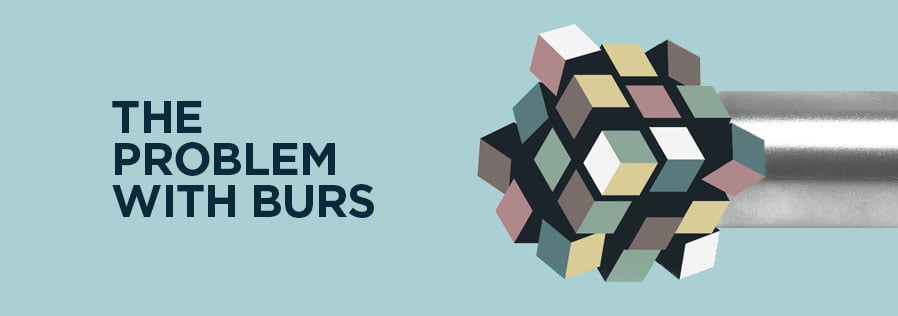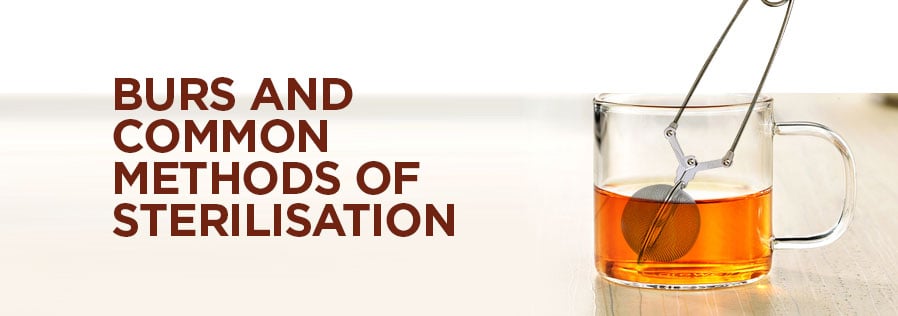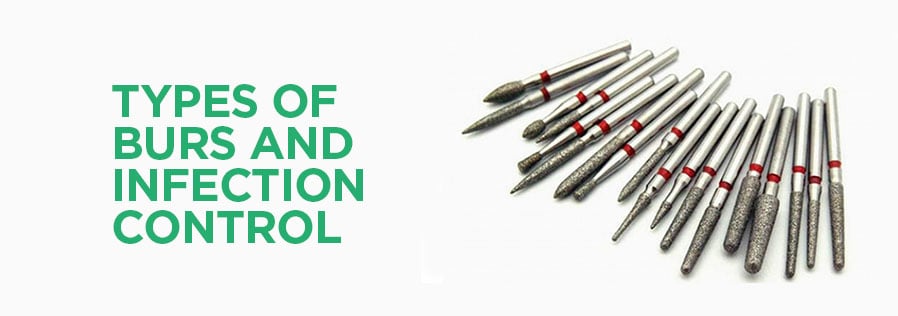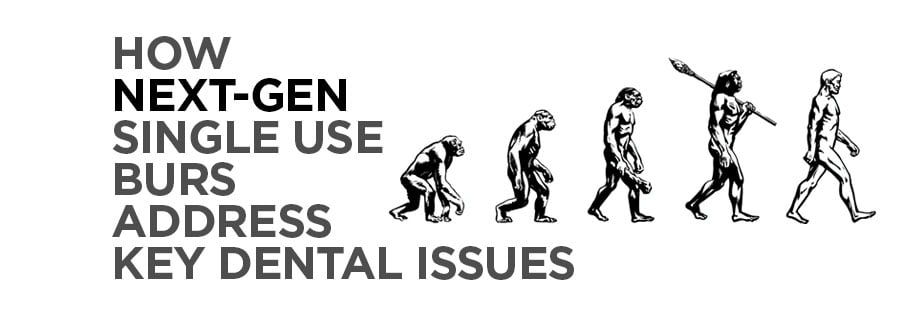The Big Bur Debate and New Infection Prevention & Control Strategies


Dental burs, the inseparable tool of dentistry, which sends fear into the hearts of even the bravest people, now also poses a major challenge for dental practitioners. Making the right choice has become more complex. And it’s not just because dental catalogues boast thousands of options, with Google adding to the confusion by serving over millions of contradicting answers. Today’s choice of burs is no longer simply about function and price. In this post we weigh in on the big bur debate in the context of infection control as the new key factor in shaping the economic future of dental practice.

With the inherent infection risks associated with dentistry, the COVID-19 pandemic has greatly impacted on the provision of dental services, eliminating the need for many high-risk and non-essential procedures. In the new normal, dentistry needs to reassess infection control and prevention strategies.
Innovation in dental burs has been driven by the desire for greater precision, speed, and efficiency, and ultimately making dental procedures a better experience for both, dentists, and patients.
The history of modern dental burs goes back more than 150 years. Following the invention of a pedal-powered drill 1868 by an American dentist, George F. Greene, in 1871, James B. Morrison invented the first pedal-powered burr drill. In 1875, the invention by Dr. Greene of the first electrical drill brought the breakthrough for the industry. From the initial heady speed of 15 rpms, today, these speeds exceed 400K rpms.
This has led to one of the two major issues for modern dentistry: creating dangerous aerosols that contribute to the risk of infection, and, the biggest, bur-specific issue, contamination. The fact is that no matter how hard and durable burs are, they cannot be fully cleaned due to the nature of the materials that make their working tip and surface of the bur.

Availability, quality and price of single use dental burs, the very factors which were questionable just a decade ago, now present a totally different picture.
Just how prominently burs feature in concerns for infection control, shows in the fact that burs are singled out in several sections of the ADA Guidelines of Infection Control.
o Standard Precautions – under “disposal of sharps”
o Infection control strategies – together with matrix bands and implant drills
o Instrument reprocessing – burs are included as a Critical Item within dental equipment and instruments
o Pre-soaking and cleaning
o Packaging
o Sterilization
ADA Guidelines state that “equipment and instruments used in the treatment of mucosal lesions or diseased soft tissue and those that come in contact with mucosa, gingiva or blood must be single-use disposable or cleaned and re-sterilised after each patient.”
Here is the bottom line: In terms of infection risks, there are 3 classes of dental instruments defined by the Spaulding classification. It outlines three levels of sterilisation or disinfection strategies for dental tools, high, intermediate, based on the degree of risk involved in their use.
Surgical burs, along with dental forceps and elevators and flap retractors fall into the critical category, which is subject to the strictest regulations. Their re-processing is guided by AS/NZS 4815 and/or AS/NZS 4187, which states that if an instrument cannot be cleaned, it cannot be reprocessed.
This, in the context of the latest pandemic and continued innovation in dental tools, has reopened the big debate: reusable vs single patient use burs.

Sterilisation is the most effective and legally required method of cleaning dental instruments to prevent infection. Autoclaving procedures are outlined in ADA Guidelines for Infection Control and must be followed in Australia under National Law.
The following common methods demonstrate issues associated with using sterilisation for reusable instruments, especially burs.
|
Method |
Process |
Advantages |
Precautions |
|
Steam |
At 121 degrees C for 20 to 30 minutes or At 134 degrees C for 2 to 10 minutes |
Good penetration |
Carbon steel corrodes, damage to plastic and rubber items, packs wet after the cycle, hard water spots instruments. |
|
Unsaturated chemical vapor |
20 minutes at 134 C |
No corrosion of carbon steel, packs are dry after cycle |
May damage plastic and rubber items. |
|
Dry heat (Oven Type) |
1 to 2 hours at 160 C |
No corrosion of carbon steel, packs dry after the cycle |
May damage plastic and rubber items, do not open door during the cycle. |
|
Dry heat (rapid heat transfer type) |
6 to 12 minutes at 191 C |
Short cycle |
May damage plastic and rubber items. |
While new disinfection and sterilisation methods are always being explored, studies show that while autoclaving is relatively the best method, none of the sterilisation methods is absolutely reliable in the decontamination of dental burs.

The seemingly endless choice of shapes and sizes of burs boil down to essentially only three commonly used types, based on the procedure requirements as well as economic reasons: stainless steel, Tungsten Carbide and diamond burs.
All bur types come with some inherent issues:
o Stainless Steel Burs are not so stainless. They are difficult to clean and become blunt and corrode, lasting 3 or 4 cleaning cycles.
o Dimond Burs clearly show that diamonds are not always a girl’s best friend. As effective as they are, they are notoriously difficult to clean and can only be used for up to 10 cycles of sterilisation.
o Carbide Burs has been the most popular type of bur. Although easier to decontaminate than diamond, it’s not without risk and involves expert mechanical cleaning by qualified staff.
Single patient use burs, despite their availability for many years, have not been as popular. Traditionally, the problem with single patient use burs has been their perceived as being lower quality and associated risks, or prohibitive cost. However, today, with improved technology, single patient use burs of the same quality as reusable ones.

There are many reasons why in this constantly accelerating life and business environment sometimes we need to opt for disposable options, at a risk of contributing to the “disposable economy”. As the focus on the importance of social responsibility is growing , the impact of disposable burs is well offset by the environmental costs of disinfecting and sterilising dental burs. Until further data emerges the big bur debate is based purely on economic choices for the dental practice.
The new bur economy has emerged. The new knowledge is transforming the rationale for selection of dental burs. The quality of single use burs has just become more affordable, made possible by the next generation burs. These innovative dental tools help promote infection prevention and control and save time and money.
When the imperative is infection prevention and control, choosing the right equipment becomes investment that reaps multiple benefits. Today, the best single patient use burs deliver:
• Improved safety from risk of infection for you, your staff, patients, and the broader community.
• Improved profitability through less time in chair that leads to higher patient turnover and savings in labour and energy cost.
• Improved opportunity to meet professional and legal obligations
• Reduced cost of labour and energy previously require for cleaning reusable tools.
• Reduced risk of losing professional and business reputation due infection breaches in the practice
• New marketing opportunity for dental practice: promoting your policy on the best single patient use burs is a great way boost trust and confidence in your community.
Let’s look at some proven examples.
Innovation in dentistry used to be driven by dentists, to address their own and patients’ needs. Today, it is driven by specialist manufacturers who have not only deep understanding of the issues of the dental profession but also access to research and technologies to develop new and better tools. Importantly, manufacturers’ medical products and devices are always subject to legal scrutiny and government regulations, thus providing dentists with extra security.
And while small, specialist manufacturers often come up with innovative products, large market leaders, have more knowledge and resources to develop innovative, high quality products, like single patient use burs, at an affordable value.
The latest example of breakthrough innovation in single use dental burs are two products, NeoDiamond® and NeoBurr® from Microcopy. Microcopy is the biggest manufacturer of diamond burs globally and has pioneered single patient use burs.
NeoDiamond® is America’s #1 selling diamond bur for a good reason. Its proprietary Triton bonding fastens diamonds to the shank with superior hardness exposing 20% more diamond cutting surface, resulting in less chair time, and its XactFit Shank has the strictest tolerances in the industry for a secure fit.
The innovation behind Microcopy’s NeoDiamond® as a single patient use diamond bur, has successfully addressed all key issues previously associated with the reusable diamond bur:
• Safety: supplied sterile, they reduce possibility of cross infection.
• Performance: superior hardness of NeoDiamond® and unrivalled strength of NeoBurr®, are proven by their sales performance and multiple industry awards.
• Price: NeoDiamond® offers comparable pricing with an approved quality diamond bur.
• Time savings: shorter duration of procedures, which improves patient experience and dentists’ own wellbeing.
• Cost savings: eliminated time for sterilisation of a reusable diamond bur and keeping track of its use in the inventory.
While the above advantages of single patient use diamond burs equally apply to a product like NeoBurr®, the innovative design of this single patient use tungsten carbide bur addresses one other critical concern of dentists: the risks of breaking burs.
Released in 2016, the Microcopy NeoBurr® features unrivalled strength due to its single-piece carbide construction and the patented blended neck™ design, which removes any weak points in the bur’s neck. In a recent blind study, NeoBurr® 5572, tested against three top-selling competitive burs, proved to be up to 70% stronger.
The voice of the industry speaks louder than any statistics. NeoBurr® was instantly recognised as a 2016 Top 100 Product by Dentistry Today, Best Product 2017 by the Dental Product Shopper, and as a Preferred Product 2017 by the Dental Advisor. NeoBurr® 330 was ranked #3 in the Top Carbides 2017 by Clinician's Report.

The backlog of preventative and restorative dental services caused by COVID-19 will dictate new choices for dentists and hygienists, with emphasis on speed, efficiency, cost, and patient’s and doctor’s safety and comfort.
Based on the facts in this article, is there a single good reason to risk the future of your business practice through false economy and not embracing products that not only ensure health safety but provide clear financial benefits?
While the evidence reviewed for this article presents compelling argument, now is the best time for dental practice leaders to explore all good information on the subject.
If you need extra information or assistance in working out the pros and cons of single use burs vs reusable burs, for your practice, call 1800 422 227 to request a product sample. And feel free to visit https://www.arkhealth.com.au/.
